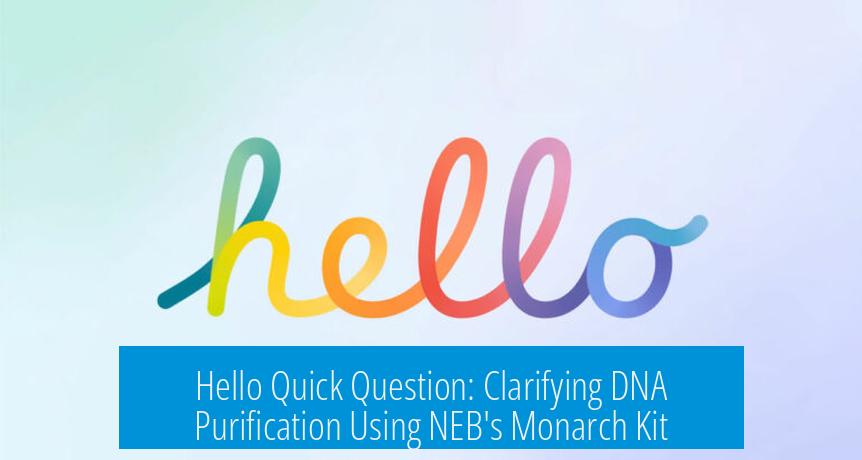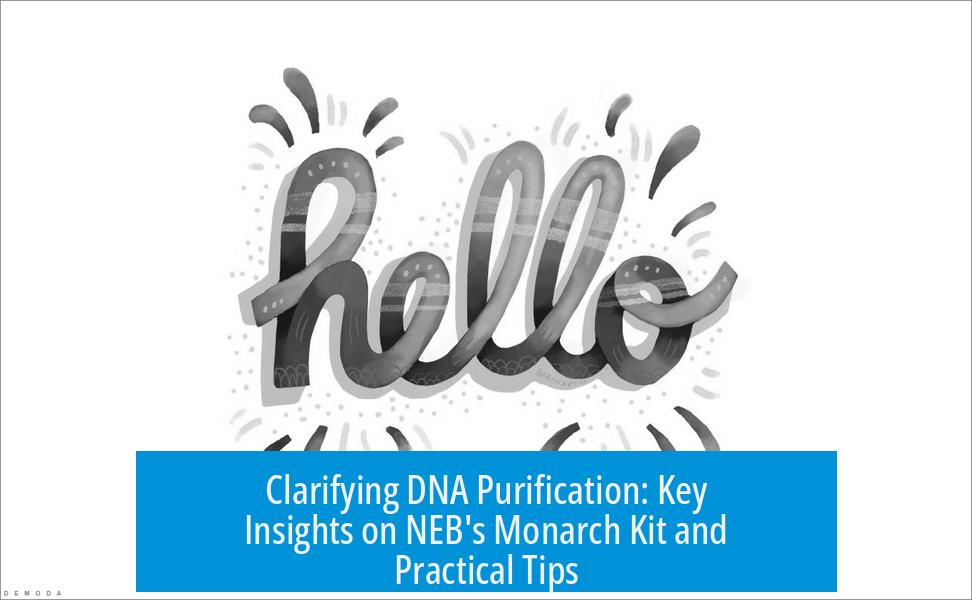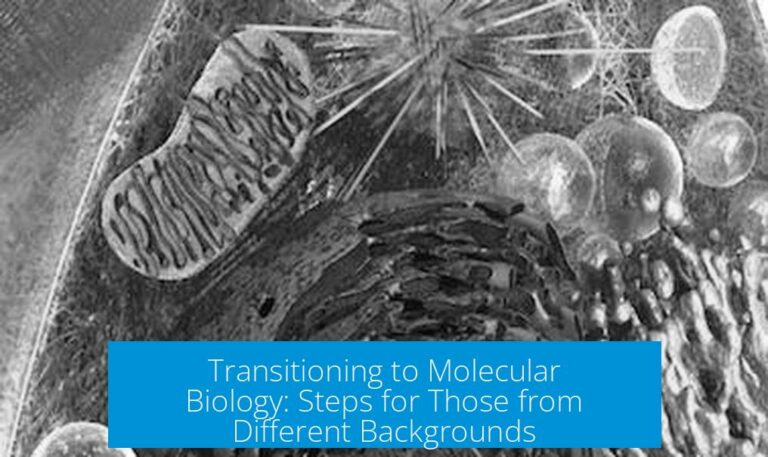Hello Quick Question: Clarifying DNA Purification Using NEB’s Monarch Kit

The 56°C incubation step in NEB’s Monarch Genomic DNA Kit facilitates protein digestion by Proteinase K, which remains active across 20–60°C, ensuring reliable breakdown of proteins during DNA extraction. This step is crucial for liberating DNA from proteins and other cellular components.
Proteinase K Activity in the Monarch Kit
Proteinase K is an enzyme used to digest proteins, enhancing DNA purity. NEB’s Monarch kit instructs incubation at 56°C, optimizing Proteinase K’s enzymatic activity. This temperature falls well within its active range (20–60°C), making the step effective across various sample types.
Choosing DNA Purification Methods by Species and Source
The choice of DNA purification also depends on the species and tissue origin. For example, Drosophila DNA can surprisingly be purified using Qiagen Gel Extraction Kits, which sometimes outperform traditional genomic extraction kits. The extraction conditions and kit should fit the sample type to maximize yield and purity.
Downstream Applications Guide Purification Strategy
The intended use of DNA impacts the purification method. If short DNA fragments suffice, such as for cloning, direct PCR amplifications using mixes like Terra Red may bypass full genome purification. The complexity and quality requirements vary with the experimental goal.
User Experience and Kit Variability

Individual experiences with DNA kits may vary due to sample differences or protocol nuances. Some uncertainty exists regarding specific kit use, highlighting the importance of trial and verification in protocol choice.
Summary of Key Points
- The 56°C step supports Proteinase K-mediated protein digestion, critical for DNA purification.
- Proteinase K functions well within 20–60°C, validating NEB’s recommendations.
- Species and DNA source influence kit selection; atypical kits may outperform standard genomic kits for some samples.
- Downstream application defines the need for DNA quality and purification rigor.
- User familiarity with kits affects protocol success; empirical optimization is advised.
Hello Quick Question: Demystifying DNA Purification with NEB’s Monarch Kit and Beyond
Got a quick question about purifying DNA? You’re in good company. Many researchers and students alike face head-scratching moments when handling kits like NEB’s Monarch Genomic DNA Kit. Let’s clear things up and dive deep into what’s really going on—without getting lost in a sea of jargon.
First off, what happens at that 56°C step? That’s the burning question many ask when following the Monarch kit protocol. Simply put, the 56°C incubation is a protein digestion step using Proteinase K. Science speaks plainly here—Proteinase K is an enzyme that chomps away proteins, freeing the DNA for you. Think of it like Pac-Man, snacking away unwanted protein bits.
Here’s the kicker: Proteinase K isn’t some picky eater; it works great over a wide temperature range. NEB advertises their Proteinase K, specifically, as most active between 20 and 60°C. Therefore, holding your sample at 56°C is absolutely fine. No mysteries or hazards here. Feel free to turn up the heat at this stage and relax knowing the enzyme is doing its job.
Does Species Matter? Oh, Absolutely!
Now, before you rush to prep your samples, consider what species you’re working with. Different creatures have different DNA quirks. For instance, if you’re dealing with Drosophila (aka fruit flies), an interesting twist emerges. You can purify Drosophila DNA from tissue culture cells using a Qiagen Gel extraction kit, and surprisingly, it might outperform some kits designed specifically for genomic DNA. Yes, you read that right. Sometimes, unconventional methods win the day.
This tidbit is vital because not all purification kits are one-size-fits-all solutions. Different species, tissue types, and sample qualities demand tailored approaches. Have you tested multiple kits or methods? If not, you might want to explore alternatives for your species, especially if the standard methods leave you frustrated.
Downstream Applications: The Master Key

Here’s a secret to save you time and money: the way you plan to use your DNA defines how you purify it. What’s your downstream application? Are you looking to clone a tiny strip of DNA? Sometimes, you can skip DNA purification entirely. Take the example where a Terra Red direct PCR mix is used directly on tissue—bypassing genome purification and still getting the job done.
This saves you from the grind of multi-step extraction and purification. If your aim is just a short stretch of DNA, direct PCR mixes can be your best friend. Just squash that tissue, add the mix, and start amplifying. Less work, less waiting, less headache.
On the other hand, if your work demands high-quality genomic DNA—for sequencing, library preparation, or extensive genomic work—you’ll want the full purification process. It really depends on how “pristine” your DNA needs to be for your experiments.
Been There, Done That: Personal Experience (Or Lack Thereof)
It’s refreshing to know that even experienced folks sometimes can’t remember which kit they used! One researcher admitted, “I can’t remember if I actually used the Monarch kit, or if it was another one.” It happens. DNA purification can feel interchangeable when multiple kits promise similar results.
This humbling admission highlights a key point: no matter how many protocols you follow, it’s good to keep records. Troubleshooting DNA extraction is easier when you know which kit you used, at what temperature, and with what tweaks.
Practical Tips for Your DNA Purification Journey
- Don’t sweat the 56°C step: Proteinase K works well there. Heat up your sample confidently during digestion.
- Match kit to species: If purifying from fruit flies, consider nontraditional kits like Qiagen Gel extraction—which can outperform some “official” genomic kits.
- Know your goal: For short DNA fragments, direct PCR mixes can save you from DNA purification. Less prep time, more results.
- Keep records: Document which kit and conditions you use. Your future self with thank you.
Final Thoughts: Ask Before You Leap
Next time you catch yourself wondering, “Hello quick question: do I really need this step or kit?” pause and reflect on your species and what you want to do with your DNA. These two factors often dictate your best approach, more than protocol rigidity.
Could you be saving time or money by choosing a different method? Are you stuck in the false comfort of “this is what everyone uses” without considering alternatives? These are questions worth pondering.
In the end, DNA purification is less about mysticism and more about strategy. Be informed, stay curious, and test smart. Your DNA—and your lab notebook—will thank you.
What is the purpose of the 56°C step in NEB’s Monarch Genomic DNA Kit?
The 56°C step involves digesting proteins using Proteinase K. This enzyme works well between 20°C and 60°C, making the 56°C incubation ideal for breaking down proteins during DNA purification.
Can I use Qiagen Gel extraction kit to purify Drosophila DNA?
Yes, Drosophila DNA can be purified from tissue culture cells using the Qiagen Gel extraction kit. It has been reported to perform better than some specific genomic DNA extraction kits for this purpose.
Is genome purification always necessary for downstream applications?
Not always. If you need a short DNA segment for cloning, you can use Terra Red direct PCR mix directly on tissue without purifying the entire genome. The need depends on the specific application.
Does the choice of DNA purification kit affect results significantly?
Results can vary with different kits. Some users might not recall which exact kit they used. Choosing a kit depends on your sample type and downstream goals, so personal experience and trial matter.





Leave a Comment